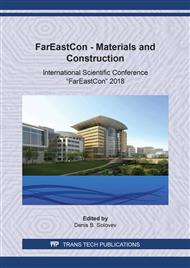[1]
V. Legagneur, J.-H. Liao, Y. An, A. et al., Li2Mn(VO3)4 ·2H2O: synthesis, crystal structure, thermal behavior and lithium insertion/deinsertion properties, Solid State Ionics. 133 (2000) 161– 70.
DOI: 10.1016/s0167-2738(00)00736-0
Google Scholar
[2]
C. Yuan, C. Li, B. Ma, X. Li, X. Cao, A facile method for low – temperature synthesis of NaV3O8 as cathode materials for lithium secondary batteries, Materials Science. 17 (2011) 65-68.
DOI: 10.5755/j01.ms.17.1.252
Google Scholar
[3]
J. Wang, X. Yao, X. Zhou, Z. Liu, Synthesis and electrochemical properties of layered lithium transition metal oxides, J. Mater. Chem. 21 (2011) 2544-2549.
DOI: 10.1039/c0jm03388j
Google Scholar
[4]
N.A. Chernova, M. Roppolo, A.C. Dillon, M.S. Whittingham, Layered vanadium and molybdenum oxides: batteries and electrochromics, J. Mater. Chem. 19 (2009) 2526-2552.
DOI: 10.1039/b819629j
Google Scholar
[5]
Y. Luo, J. luo, J. Jiang, W. Zhou, H. Yang et. al., Seed – assisted synthesis of highly ordered TiO2@α-Fe2O3 core/shell arrays on carbon textiles for lithium – ion battery applications, Energy Environ. Sci. 5 (2012) 6559–6566.
DOI: 10.1039/c2ee03396h
Google Scholar
[6]
Y. Zhao, X. Li, B. Yan, D. Xiong, D. Li, S. Lawes, Recent developments and understanding of novel mixed transition-metal oxides as anodes in lithium ion batteries, Adv. Energy Mater. 6 (2016) 1502175.
DOI: 10.1002/aenm.201502175
Google Scholar
[7]
C. Yuan, H. Wu, Yi Xie, X. W. (David) Lou, Mixed transition-metal oxides: design, synthesis, and energy-related applications, Angew. Chem. Ind. Ed. 53 (2014) 1488-1504.
DOI: 10.1002/anie.201303971
Google Scholar
[8]
P. He, H. Yu, De Lia, H. Zhou, Layered lithium transition metal oxide cathodes towards high energy lithium-ion batteries, J. Mater. Chem. 22 (2012) 3680-3695.
DOI: 10.1039/c2jm14305d
Google Scholar
[9]
S.Y. Lin, C.M. Wang, K.S. Kao et al., Electrochromic properties of MoO3 thin films derived by a sol–gel process, J Sol-Gel Sci Technol. 53 (2010) 51-58.
DOI: 10.1007/s10971-009-2055-6
Google Scholar
[10]
K. Eda, Y. Uno, N. Nagai, N. Sotani, M.S. Whittingham, Crystal structure of cobalt molybdate hydrate CoMoO4·nH2O, Jounal of Solid State Chemistry. 178 (2005) 2791–2797.
DOI: 10.1016/j.jssc.2005.06.014
Google Scholar
[11]
R.D. Apostolova, E.M. Shembel, V.M. Nagirnyi, Synthesis and investigations of electrolytic sodium - vanadium oxide compounds for cathodes of lithium batteries: the production of compounds with stable initial characteristics, Russian Journal of Electrochemistry. 36 (2000) 36–42.
DOI: 10.1007/bf02757793
Google Scholar
[12]
X. Xia, J. Tu, Y. Zhang, X. Wang, Ch. Gu, Xin-bing Zhao, Hong Jin Fan, High-Quality Metal Oxide Core/Shell Nanowire Arrays on Conductive Substrates for Electrochemical Energy Storage, ACS Nano. 6 (2012) 5531–5538.
DOI: 10.1021/nn301454q
Google Scholar
[13]
V. Legagneur, J.-H. Liao, Y. An, A. Le Gal La Salle, A. Verbaere, Y. Piffard, D. Guyomard, Li2Mn(VO3)4∙2H2O: synthesis, crystal structure, thermal behavior and lithium insertion/deinsertion properties, Solid State Ionics. 133 (2000) 161–170.
DOI: 10.1016/s0167-2738(00)00736-0
Google Scholar
[14]
N.P. Klochko, N.D. Volkova, V.V. Starikov et al., Utilization of alternating current methods for manufacture of selective absorbing coatings for heat collectors, Functional Materials. 12 (2005) 123–125.
Google Scholar
[15]
J. Zhang, H. Ge, Z. Li, Z. Ding, Internal heating of lithium – ion batteries using alternating current based on the heat generation model in frequency domain, Journal of Power Sources. 273 (2015) 1030–1037.
DOI: 10.1016/j.jpowsour.2014.09.181
Google Scholar
[16]
T. Abdulla, A Yerokhin., R. Goodall, Effect of plasma electrolytic oxidation coating of the specific strength, Materials and design. 32 (2011) 3742–3749.
DOI: 10.1016/j.matdes.2011.03.053
Google Scholar
[17]
T. Yoshioka, A. Chavez – Valdez, J.A. Rocther et al., AC electrophoretic deposition of organic – inorganic composite coatings, Journal of colloid and interface science. 392 (2013) 167–171.
DOI: 10.1016/j.jcis.2012.09.087
Google Scholar
[18]
R.D. Apostolova, E.M. Shembel, V.M. Nagirnyi, Synthesis and investigations of electrolytic sodium - vanadium oxide compounds for cathodes of lithium batteries: the production of compounds with stable initial characteristics, Russian Journal of Electrochemistry. 36 (2000) 36–42.
DOI: 10.1007/bf02757793
Google Scholar
[19]
Zh.I. Bespalova, A.V. Khramenkova. The use of transient electrolysis in the technology of oxide composite nanostructured materials: review, Nanosystems: Physics, Chemistry, Mathematics. 3 (2016) 433–450.
DOI: 10.17586/2220-8054-2016-7-3-433-450
Google Scholar
[20]
H. B. Wu, J. S. Chen, H. H. Hng, X. W. (David) Lou, Nanostructured metal oxide-based materials as advanced anodes for lithium-ion batteries, Nanoscale. 4 (2012) 2526–2542.
DOI: 10.1039/c2nr11966h
Google Scholar


